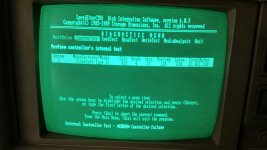Rubix
Experienced Member
- Joined
- May 20, 2007
- Messages
- 163
Hi all,
Yesterday I repaired a Compaq Portable II with dual disk drives. It's not in a great condition; lots of shorted tantalum capacitors and sticky drive doors. But it works now for the most part.
However, I can't get the Hardcard 20 that was in it to work. Maybe it's broken, but maybe I'm just doing something wrong.
One thing I did was of course pull the CMOS battery of 1989 out, so I have no info on the original configuration.
Symptoms:
I have configured the BIOS as follows:
I have tried setting drive C to Type 2 but that didn't make a difference.
The jumper on the Hardcard was set to 'PC' (not 'XT') and I think that that is correct, since the Portable II doesn't have a factory HDD card installed.
Any suggestions? This card looks really cool and I would love to get it to operate correctly.
Thanks!
Yesterday I repaired a Compaq Portable II with dual disk drives. It's not in a great condition; lots of shorted tantalum capacitors and sticky drive doors. But it works now for the most part.
However, I can't get the Hardcard 20 that was in it to work. Maybe it's broken, but maybe I'm just doing something wrong.
One thing I did was of course pull the CMOS battery of 1989 out, so I have no info on the original configuration.
Symptoms:
- After memory and floppy tests, the BIOS then hangs with a little static + in the top right corner, for about 5 minutes. Then the computer continues to boot.
- I changed the jumper on the card from PC to XT, but then it immediately (without the long pause) shows error 1701.
- When I try to install the Hardcard with the disk image I found on this forum, it shows a message saying that it can't communicate with the Hardcard. So apparently the installer doesn't find it at all.
- The drive does spin up. It doesn't seek but that could be because the controller card hasn't initialized.
I have configured the BIOS as follows:
- Drive A and B 360K floppy drives
- No HDD's (so no C and D drive)
I have tried setting drive C to Type 2 but that didn't make a difference.
The jumper on the Hardcard was set to 'PC' (not 'XT') and I think that that is correct, since the Portable II doesn't have a factory HDD card installed.
Any suggestions? This card looks really cool and I would love to get it to operate correctly.
Thanks!

